‘Project Hospital’ is A Great Way to Understand Our Broken Healthcare System
Credit to Author: Ian Boudreau| Date: Thu, 16 May 2019 14:39:02 +0000
My father has always been a doctor, at least as far as I’m concerned. He was the director of a rural New York hospital for a decade, and he worked in family practice since before I was born. For all that, I never really understood all that much about his job, what it was that actually filled his days and occupied his thoughts when he wasn’t with patients. The incomprehension was mutual, over time: most of the games I cover and talk about in my chosen profession bead off his consciousness like water off a duck’s back. So when I discovered Project Hospital, I was excited to show it to him—it was that rare opportunity for a video game to provide a means for us to connect across our different professions and interests.
Project Hospital is a game very much in the mould of Theme Hospital, but with a decidedly more serious approach to the subject matter. It’s a bit of a rarity—of the games that have taken on healthcare as their topic, almost all of them ( Theme Hospital, Two Point Hospital, Surgeon Simulator) have all been goof-fests. Project Hospital isn’t: It’s a serious management sim that wants to realistically show players something about how hospitals work.
This was Dad’s work too, and he loved it. Or parts of it. I remember dozens of dinner conversations in which he’d excitedly describe difficult cases of inserting emergency airway tubes into patients that arrived at his ER, unable to breathe on their own. It’s clear to me he loves this side of the job, while the administrative side of the role has been a much less natural fit. Drawing up schedules for other physicians to keep the ER running was something he intensely disliked, almost as much as attending mandatory meetings required by hospital management.
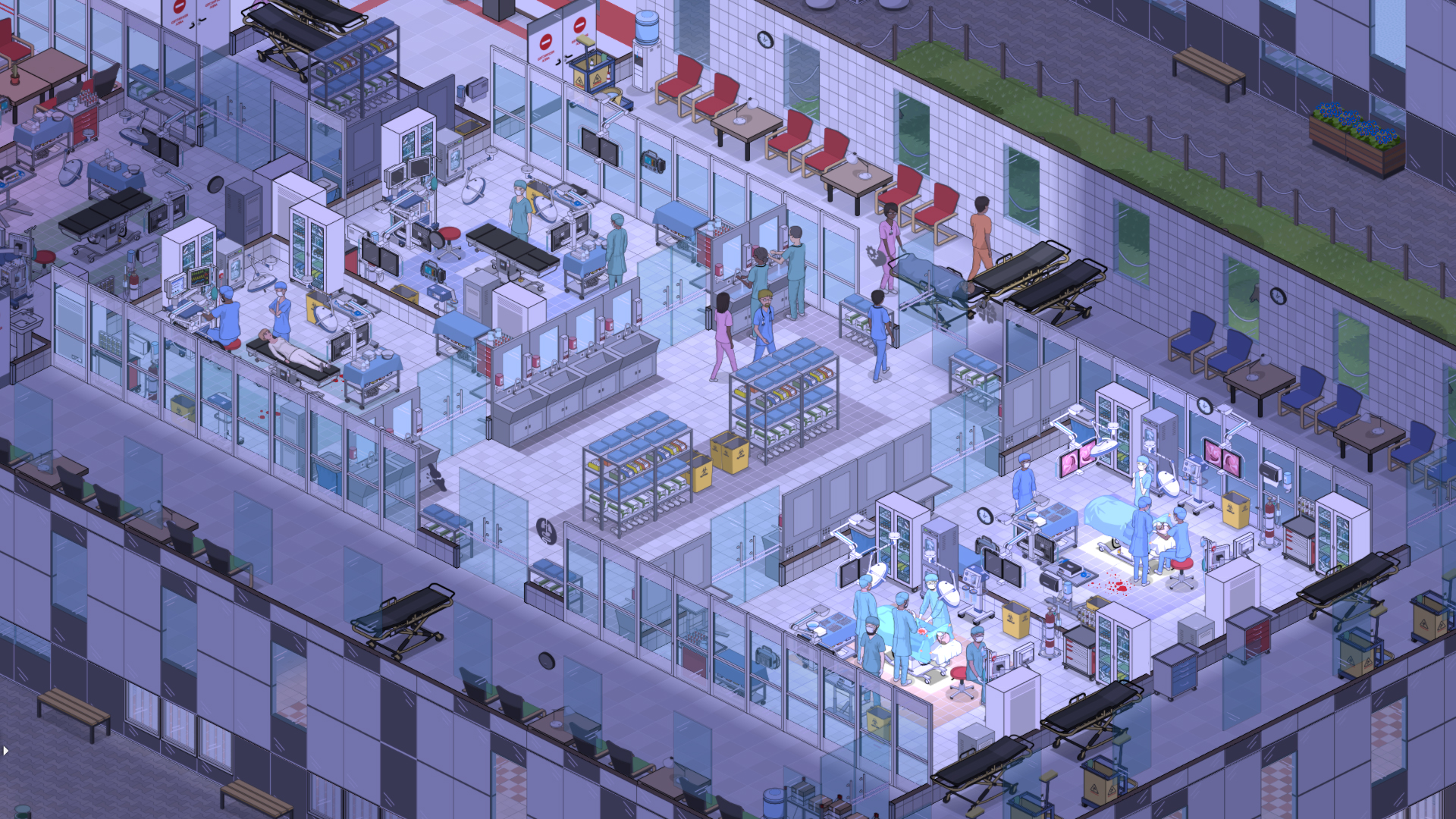
Of course, it’s still a game, and games are supposed to be fun. I wanted Dad to show me where Project Hospital was different from a real hospital. I thought that would be an interesting thing to write about—how despite the best of intentions, simulation games always have to cut corners somewhere and fit things into a framework of fun.
But the more I talked with him, the more I felt a creeping unease both at how the supposedly gamey elements of Project Hospital mirror elements of the real U.S. healthcare system, particularly in the structural incentives to do more, charge more, bill more. That’s how management sims like Project Hospital or Parkitect or Railroad Tycoon work: you want to do as many things as you can and make sure those things are as expensive as possible. You’re creating efficiencies in the physical space available to you in order to extract the highest possible profit per hour. This loop keeps the game engaging: It’s a system that you can learn, develop, and master, with difficulty and complexity increasing as the scenarios get larger and new elements are introduced. But Project Hospital is a game, and the healthcare industry is supposed to keep people alive. And that makes the similarities between the two at first fascinating, and then unnerving.
On my laptop at my parents’ dining room table, Dad and I watched as my ER staff moved a cartoon woman off an ambulance.
“So what’s the story with this patient?” he asked, as they wheeled the gurney into the trauma bay.
I clicked on the cartoon woman on the gurney, who was being wheeled into a trauma bay. A pop-up menu listed her symptoms, including a swollen ankle, which Dad said could indicate a dislocation.

He asked where my imaging department was, and I showed him: it was three floors up, and… severely under construction. I had put in a new CT scanner on one side of the unfinished third floor, which also housed my X-ray unit. It was sitting on bare subfloor, in an area where I hadn’t even gotten around to putting in wall partitions. I had thought to hire a technician to run the machine, and the poor guy was standing near the new CT scanner, looking bewildered. Building him a workspace, with a desk and computer and chair to sit in, was still on my to-do list.
“That’s no good,” Dad said, shaking his head. You want patients to be able to get from the ER to Radiology quickly, he explained, and a three-story elevator trip was going to be a problem. Fortunately, the X-ray department was fully functional, and when my patient finally made her way up, they found that Dad was absolutely correct: she had a dislocated ankle.
“She’ll need a closed reduction,” Dad said, almost automatically. I was delighted for two reasons—first, that he was actually connecting with a video game I was showing him. Second, because his clinical recommendation for my patient was right there on Project Hospital’s list of available treatments. I selected closed reduction on her chart, and she was wheeled off to have someone pop her ankle back into place.
Project Hospital is full of little details drawn from the everyday practice of medicine. Patients show up with sprains, cuts, or hayfever. I’ve had several come in suffering from Raynaud’s Syndrome, which is a condition that causes the blood vessels in the hands and feet to constrict, making the fingers and toes painfully cold.
As a management sim, Project Hospital also wants to recreate the triage pipeline you’d find in a real hospital. There’s a complex flowchart you can pull up that details the path patients move along from intake to hospitalization, transfer, or discharge. You need to make sure each step along the way, and each department they might need to visit, is properly staffed, and that those staffers—doctors, specialists, techs, nurses, and building maintenance crew—all have physical places to work and do their jobs, and that they aren’t tripping over each other along the way. In Building Mode, you can add floors and elevators, parking areas and trauma bays. It’s satisfying in that calming way games like Rollercoaster Tycoon so often are, but with a welcome seriousness about its subject matter.
It’s when you look at it from a patient’s point of view that it all falls apart.
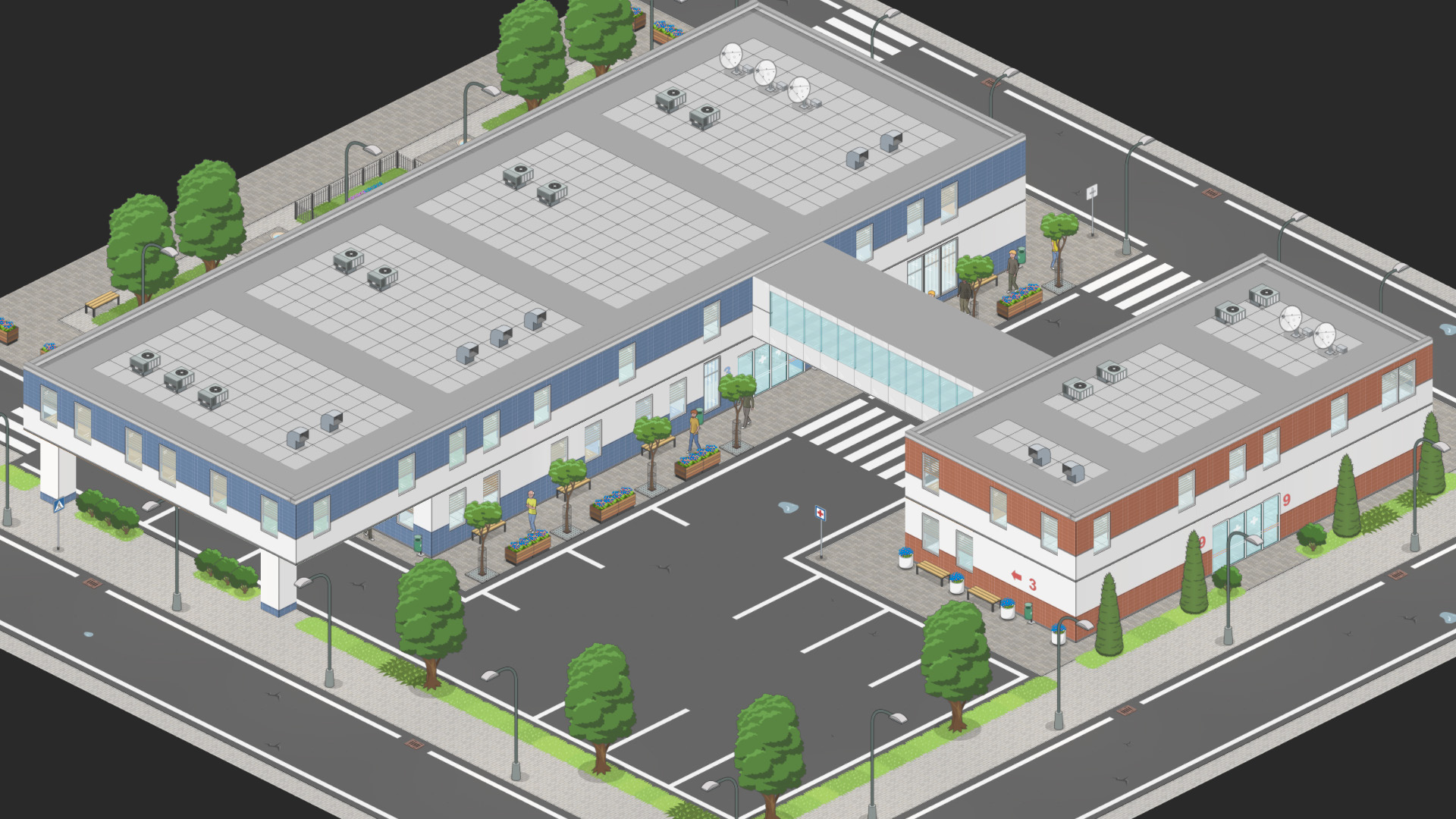
Project Hospital isn’t meant to be much of a simulation. When I reached out to the Prague-based indie studio Oxymoron games to ask about their game, lead programmer Jan Beneš told me that the issue of realism was one the team thought about every day… but mostly in order to capture the feel of a popular TV medical drama like ER. So we have a game that attempts to model the breakneck, “every-second-counts” feel of a TV drama and parrot the appropriate medical terminology and procedures. When it comes to the business side of emergency medicine, however, Project Hospital at first appears to be simplified to an extreme.
Patients arrive at your hospital carrying a policy from one of a number of insurers, which vary in quality. This is represented by a percentage: a low-quality insurer pays 70 percent of the “retail” price of a procedure, while a higher-quality insurer will pay something like 120 percent. You can decide which insurers you want to accept, which is a way to control the flow of patients into your hospital. In the game, uninsured patients do not exist.
According to Beneš, however, the team didn’t really give much thought to this aspect of the game, or take inspiration from US healthcare debates over the last 30 years. They mostly just needed something plausible to take the place of their game’s economy.
“The insurance system in the game has evolved to mostly suit gameplay needs rather than mimic a specific real-world system,” Beneš wrote in an email.
It comes as a bit of a shock then to learn how close Beneš and Oxymoron wound up getting to the actual relationship between real-world hospitals and insurance companies where. Americans spent $3.5 trillion on healthcare expenditures in 2017.
As a non-expert, I often find myself imagining the healthcare system as a monolith. Perhaps nightmarishly complex, but still a single structure that encompasses everyone and everything involving healthcare in this country. This is a mistake. The “healthcare system” is more of an aggregation of systems operated by different stakeholders: providers, insurers, caregivers, specialists, policymakers, researchers, administrators, and countless others who all work for individual businesses or agencies. The complexity is not shared equally. In fact, for hospitals providing emergency medical care, it’s not that complicated at all. Project Hospital may use an extremely simplified “insurance” system to handle the financial aspect of its business simulation, sure, but that simple lemonade-stand business simulation is more or less how many American hospitals operate.
Dad and I talked about the business side of hospitals long after I’d closed the laptop I had been using to show him Project Hospital. He explained how all of his hospital’s operating budget is based on what it bills. That’s how it works in the game, too: You’re trying to perform and bill for the most procedures possible while keeping your overhead as low as possible. There’s the option to take out a loan (with interest), but generally speaking you’re trying to stay in the black by reducing your operational costs and increasing the number of patients you treat.
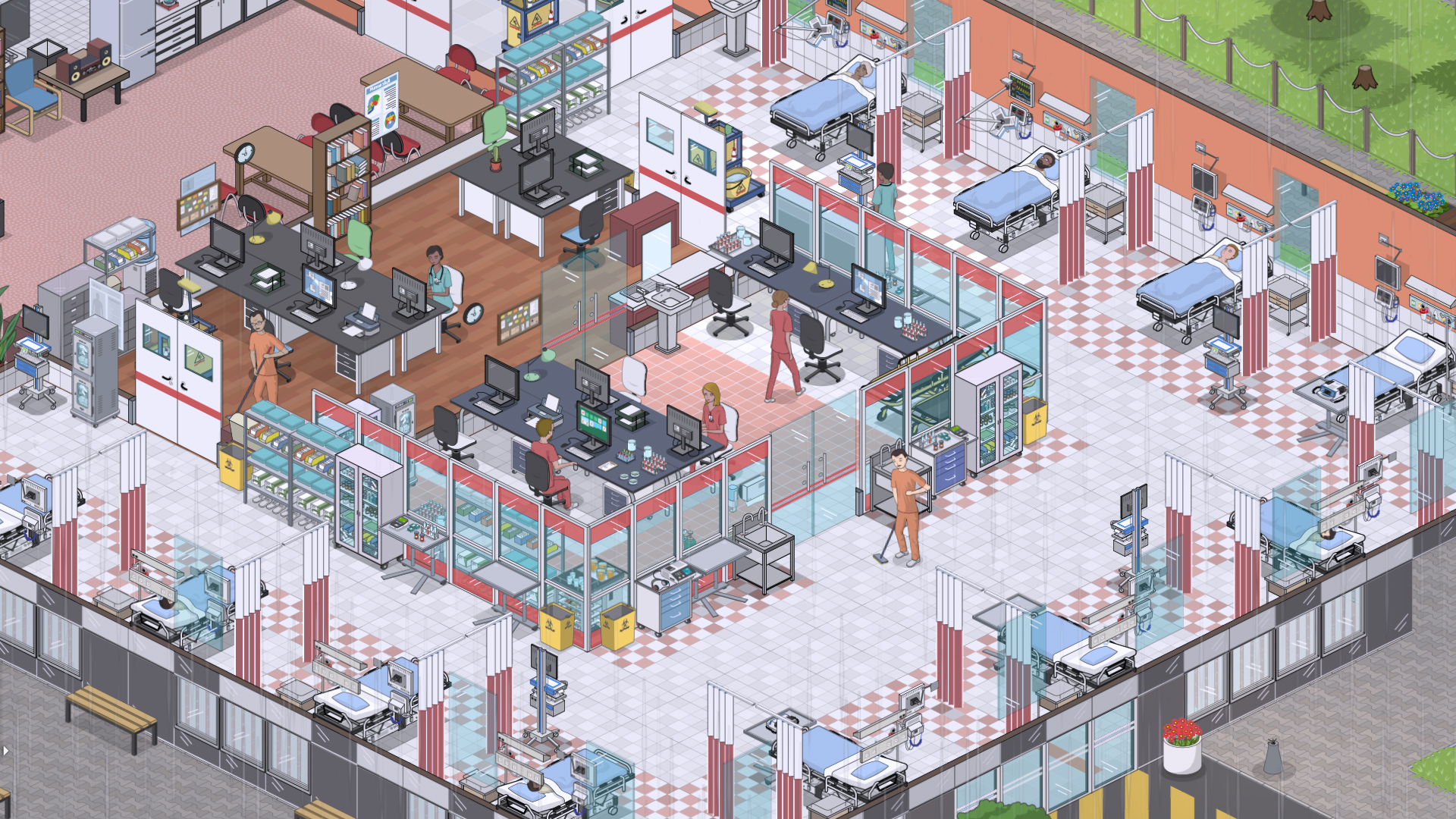
Whether by design or because of the strength of its simulation, Project Hospital accurately reflects real-world healthcare facilities’ physical layouts. My dad’s hospital recently was approved for a large state grant to renovate its emergency room. The current ER layout is linear, with bays laid out along a long corridor that requires doctors and nurses to walk a long way to see patients at the far end. The plan is to bring the ER up to modern design standards by placing the main workspace in the center and arranging bays and beds around that, exactly the way you’d want to build a clinic in Project Hospital. It’s an example of an efficiency that serves both patient and provider: patients are better looked-after and get quicker responses, and staff waste less time walking the halls.
Those similarities between game and reality extend, at least conceptually, to the way healthcare professionals are evaluated. In the game, staffers have star ratings that indicate how good they are at their jobs, whether they’re doctors or janitors. In Project Hospital, better doctors diagnose patients faster and more accurately, better nurses can treat more patients before needing a break, better janitors clean up blood and empty trash bins faster. Faster is better: There’s of course the need to stabilize patients who are bleeding out or collapsing, but what matters most to you, the all-seeing administrator, is that you bill as many patients as possible over the course of the day. You’re paying these people, after all.
Dad explained how real-world healthcare workers have their time on the clock measured by “relative value units,” which are calculated using a formula that adds up the amount of work each procedure is expected to take, the expense of running a practice, and the expected liability insurance costs, and then uses this figure to determine reimbursement from Medicare. For budgeting and billing calculations, RVUs are assigned to each of more than 7,500 physician services, and then multiplied by a dollar conversion factor. Effectively, that means hospitals want their doctors to maximize the number of RVUs, and the number ends up being a rating of sorts. More RVUs means, from the hospital’s point of view (if not the patients’), a better physician. It’s a quick way to look at how effective your doctors are, and at the end of the day, it’s not conceptually much different from the simple five-star rating system in Project Hospital.
In the real world, that logic increasingly applies to patients themselves. As it turns out, there’s a recent trend in outpatient care in which practices actually “fire” patients. Dad told me that it’s become a standard business practice: If someone misses two appointments, they can be barred from ever seeking care at that office again. Dad’s been close to being fired by his own dentist, in fact.
“That seems, I don’t know, kind of close to being unconstitutional or something,” I said, baffled.
We were talking over the phone, but I could almost hear him shrug his shoulders.
“Well, it’s how it has to work,” he said. If you’re running a business, he said, you have to extract every possible dollar out of every hour you have your doors open, and that means taking on patients who waste time or might be a liability somehow isn’t in your best interest.
Fair enough: that’s what’s meant by a private healthcare industry. The thing is, healthcare doesn’t operate according to tidy Adam Smith-esque notions of a free market. In the suburbs, exurbs, and rural areas of America, hospitals and clinics operate largely without any kind of competition. As Dad explained, in New York at least, anyone who wants to break ground on a new healthcare facility or an expansion to an existing facility has to obtain a ‘certificate of need’ from the state—in other words, they have to demonstrate that the area where they’re building actually has a need for the planned facility, either because there isn’t a duplicative facility nearby or because the local population is large enough to need another one. If you can’t get a certificate of need, you can’t get approval to build. It’s that simple.
Effectively, what that means is that a lot of private healthcare in the U.S. operates without one of the supposed main benefits of capitalism, the pressure to keep prices low in a competitive market. This oligopoly is not unlike that of internet service providers: a market in which a select few competitors are protected by the state from outside interference. So even if people in urgent need of medical care somehow had the presence of mind, time, and information to “shop around” for more optimal care providers, they often won’t have but a scant handful of options to choose from.
Predictably, what that means for consumers that out-of-pocket expenses for healthcare continue to increase year over year, finally reaching the absurd situation we’re in now, spending about twice the average per capita on healthcare while observing markedly substandard health outcomes compared to other industrialized nations.
Dad and I are on opposite political sides of the healthcare issue. He’s vocally opposed to liberal efforts to socialize or nationalize healthcare, often pointing to long wait times in Canada to illustrate the problems with “rationed healthcare.” But he’s hardly unrealistic about the state of care in the U.S., and our conversations about Project Hospital focused on the frustrations he’s had with it as it’s changed over the course of his 40-year career as a physician. When I point out that insurance companies also are in the business of rationing health care, he begrudgingly agrees, and doesn’t have an easy answer at hand.
That part of the “system,” to him, is about as opaque and impersonal as it is to me or anyone else, it seems. At different points in his career he’s butted heads with administrators and managers who are much more profit-oriented than patient-oriented—not out of preference, but because that’s how the business works.
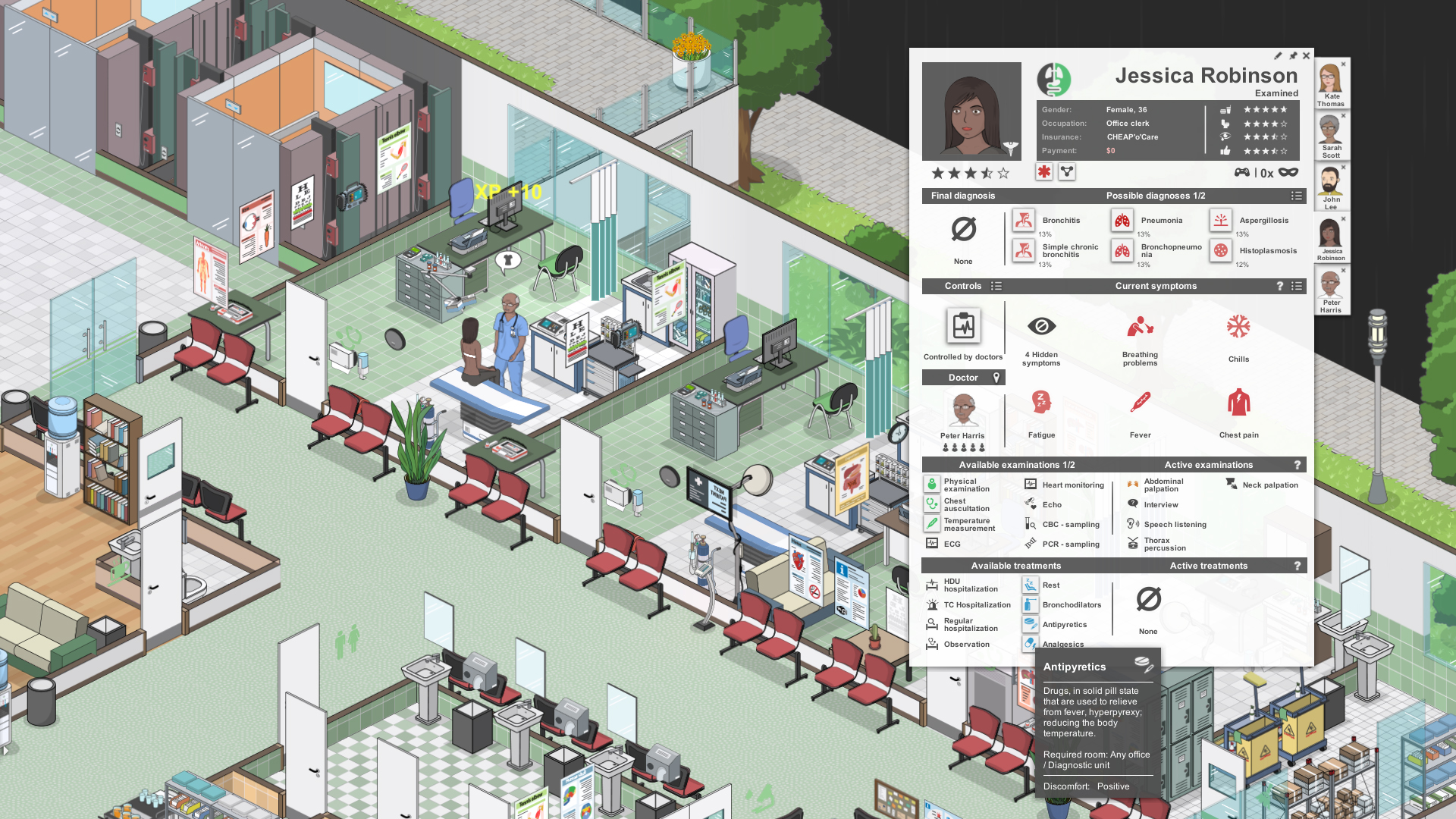
I’m still not entirely sure of what to make of Project Hospital’s uncanny and apparently accidental similarity to its real-world subject matter. I’m a fan of management sims in general, and its cheerful graphics and calming soundtrack help pull me into the gameplay loop that makes me want nothing more than to endlessly fiddle with my triage chain or staff roster. Sometimes it’s fun just to click on an incoming patient and watch her journey from admittance to discharge. There’s a joy in seeing a complex machine you’ve helped create function as intended.
It was a surprise to learn that this isn’t just a standard management sim with a stethoscope around its neck. Or perhaps more accurately, it was a surprise to find out how much real hospitals function as if they were management sims themselves. Talking about it with my dad highlighted for me how the real complexity of the “healthcare system”—the complexity we talk about when we say that healthcare is complicated—happens almost entirely off-site as a function of the insurance industry and its decisions about how healthcare is paid for and delivered.
That huge $3.5 trillion figure on the cost of healthcare masks a lot of important information, notably how much of that spending is captured by insurers. Cigna Corporation, Anthem, and UnitedHealth Group—three major health insurance providers—have all seen their stock prices more than quadruple over the past ten years. Clearly, the Affordable Care Act has worked out well for them.
It’s less clear how well it’s doing for consumers. More and more “healthcare dollars” spent by Americans are taken as cuts by health insurance companies, who offer increasingly byzantine plans dictating what is and isn’t covered, forcing consumers to essentially bet against getting sick. Cheaper, high-deductible plans cause people to delay seeking medical treatment for ailments, with deadly results. More Americans are covered now, and that’s good—but health insurance premiums continue to increase every year (the average individual plan cost $271 a month in 2014, and is now more than $440 per month), and there are still plans out there that cover what amounts to nothing. People are still rationing insulin and launching crowdfunding campaigns to pay for emergency care.
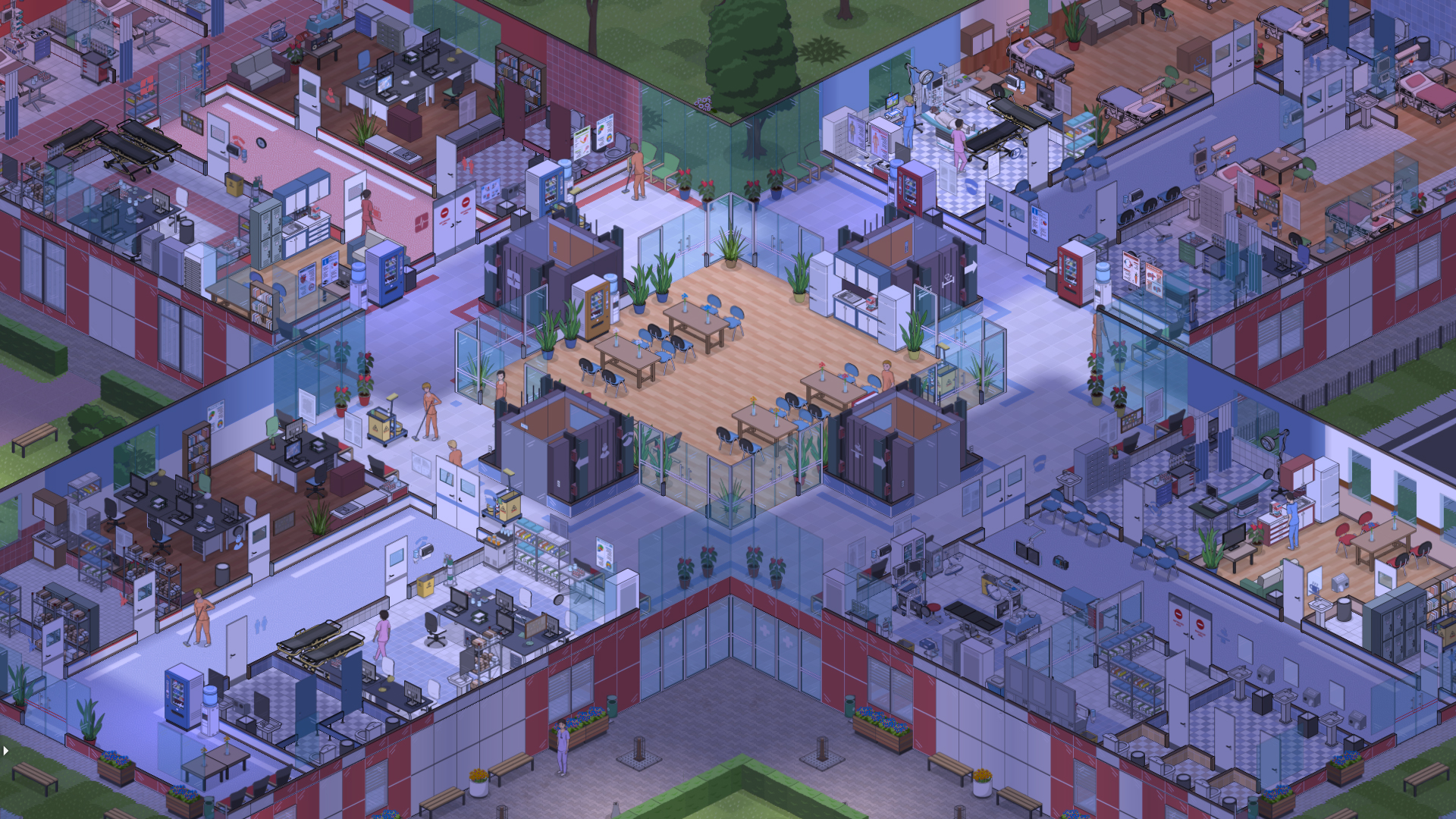
That aspect of healthcare is entirely absent from Project Hospital, and appropriately enough, as it turns out. Someone comes into the hospital in distress, and it’s their job to help that person however they can.
“Nobody I work with, whether they’re doctors, nurses, physician’s assistants, or janitorial staff, takes a patient’s ability to pay into account before we care for them,” Dad said.
My dad’s not in medicine to make money, and neither are the people he spends his working days with. They want to cure people, to relieve suffering. That’s why they went to medical school, or studied nursing, or applied to work at a hospital.
Of course, that’s not the end of the story. Project Hospital, like many of the medical dramas that inspire it , exists in a universe where otherwise healthy people are fully treated within the confines of a single visit to a single facility. The long-term costs paid by the patient are unseen. Nor is the emergency room the place where doctors confront the broken reality of a healthcare system built on the quicksand of the insurance industry. That happens offstage, dispassionately, when a letter from an insurer or an operator on the phone lets someone know that a necessary procedure for recovery or treatment has been denied or was never covered in the first place. Meanwhile, your business is chugging along, blissfully unaware of the human misery that exists all beyond the margins of the simulation.
This article originally appeared on VICE US.